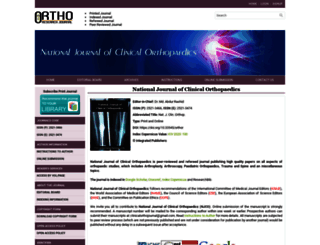National Journal of Clinical Orthopaedics | National Journal of Clinical Orthopaedics
Page Load Speed
1.4 sec in total
First Response
110 ms
Resources Loaded
1.2 sec
Page Rendered
102 ms

About Website
Welcome to orthoresearchjournal.com homepage info - get ready to check Orthoresearch Journal best content right away, or after learning these important things about orthoresearchjournal.com
An international open-access and peer-reviewed journal publishing high quality papers on all aspects of orthopaedic studies, which includes Arthroplasty, Arthroscopy, Paediatric Orthopaedics, Trauma a...
Visit orthoresearchjournal.comKey Findings
We analyzed Orthoresearchjournal.com page load time and found that the first response time was 110 ms and then it took 1.3 sec to load all DOM resources and completely render a web page. This is quite a good result, as only 25% of websites can load faster.